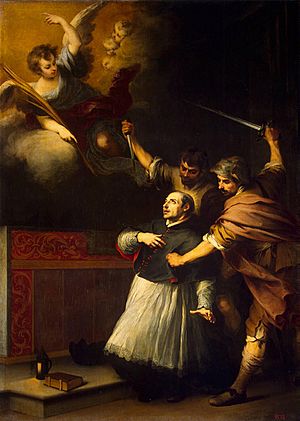Pedro de Arbués facts for kids
Quick facts for kids SaintPedro de Arbués CanReg |
|
|---|---|

|
|
| Martyr | |
| Born | ca. 1441 Épila, Kingdom of Aragon |
| Died | 17 September 1485 (aged 44) Zaragoza, Kingdom of Aragon |
| Venerated in | Roman Catholic Church |
| Beatified | 20 April 1664, Saint Peter's Basilica, Papal States by Pope Alexander VII |
| Canonized | 29 June 1867, Saint Peter's Basilica, Papal States by Pope Pius IX |
| Major shrine | Cathedral of the Savior, Zaragoza, Spain |
| Feast | 17 September |
Pedro de Arbués, also known as Peter of Arbués, was a Spanish Catholic priest. He was born around 1441 and died on September 17, 1485. Pedro de Arbués was an official of the Spanish Inquisition. He was killed in the La Seo Cathedral in Zaragoza in 1485. After his death, he quickly became a very respected figure. His death helped the Inquisitor-General Tomás de Torquemada in his efforts against heretics and people secretly practicing Judaism. Pedro de Arbués was made a saint on June 29, 1867.
Contents
Pedro de Arbués's Life Story
Early Life and Education
Pedro de Arbués was born in Épila, a town in the region of Zaragoza. His parents were Antonio de Arbués, a nobleman, and Sancia Ruiz.
He studied philosophy, possibly in Huesca. Later, he received a scholarship to study at the Spanish College of Saint Clement in Bologna, Italy. This college was part of the University of Bologna. He earned his doctorate degree in 1473. During this time, he also taught moral philosophy, which is about ethics.
After finishing his studies, Pedro de Arbués returned to Spain. In 1474, he joined the group of canons regular at La Seo Cathedral. Canons regular are priests who live together under a religious rule.
Joining the Inquisition
Around this time, the rulers of Spain, Ferdinand and Isabella, wanted to set up a special court. This court was called the Inquisition. Its job was to find people who were secretly practicing other religions, especially Judaism, even though they had said they were Christian. These people were known as conversos or judaizantes.
In 1483, Tomás de Torquemada was appointed as the main leader of the Inquisition for the region of Castile. Torquemada then chose Pedro de Arbués and Pedro Gaspar Juglar to be Inquisitors in the Kingdom of Aragon. They started their work on May 4, 1484. Many people, especially conversos, did not like their work. They felt it was a threat to their freedoms.
His Death and Its Impact
Pedro de Arbués knew his work as an Inquisitor was dangerous. He often wore armor, including a helmet and chain mail under his clothes, for protection. On September 14, 1485, he was attacked while he was praying at the altar in the cathedral. Even with his armor, he was badly wounded. He died from his injuries three days later, on September 17. His body was buried in a special chapel dedicated to him.
The Inquisition was not popular in Aragon. Many people saw it as an attempt by Castile to control their local laws and rights. Some powerful families of converted Jews were thought to be involved in planning his murder.
After Pedro de Arbués's death, there was a strong reaction against those accused of being involved. Many people were punished. Historians like Jerónimo Zurita recorded these events. Pedro de Arbués is one of the very few Inquisitors who were killed in this way.
Becoming a Saint
Pedro de Arbués was officially recognized as "blessed" (beatified) by Pope Alexander VII. This ceremony took place in Rome on April 20, 1664.
Later, he was made a saint (canonized) on June 29, 1867. This decision was made by Pope Pius IX. His canonization was a significant event for the Catholic Church.
Images for kids
See also
 In Spanish: Pedro Arbués para niños
In Spanish: Pedro Arbués para niños


